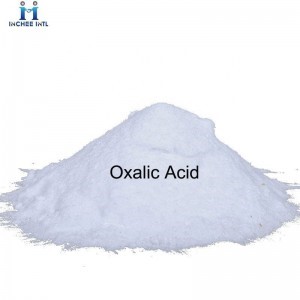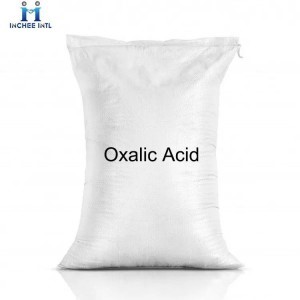Oxalic acid is an organic substance. The chemical form is H₂C₂O₄. It is a metabolic product of organisms. It is a two-component weak acid. It is widely distributed in plant, animal, and fungal bodies. It performs various functions in different living organisms. Therefore, oxalic acid is often regarded as an antagonist for the absorption and utilization of mineral elements. Its anhydride is carbon trioxide.
 Characteristics: Colorless monoclinic sheet or prismatic crystal or white powder, oxalic acid odorless by oxidation, oxalic acid taste by synthesis. Sublimation at 150 ~ 160 ℃. It can be weathered in hot dry air. 1g is soluble in 7mL water, 2mL boiling water, 2.5mL ethanol, 1.8mL boiling ethanol, 100mL ether, 5.5mL glycerin, and insoluble in benzene, chloroform and petroleum ether. 0.1mol/L solution has a pH of 1.3. The relative density (water =1) is 1.653. Melting point 189.5 ℃.
Characteristics: Colorless monoclinic sheet or prismatic crystal or white powder, oxalic acid odorless by oxidation, oxalic acid taste by synthesis. Sublimation at 150 ~ 160 ℃. It can be weathered in hot dry air. 1g is soluble in 7mL water, 2mL boiling water, 2.5mL ethanol, 1.8mL boiling ethanol, 100mL ether, 5.5mL glycerin, and insoluble in benzene, chloroform and petroleum ether. 0.1mol/L solution has a pH of 1.3. The relative density (water =1) is 1.653. Melting point 189.5 ℃.
Chemical properties: Oxalic acid, also known as glycolic acid, is widely found in plant foods. Oxalic acid is a colorless columnar crystal, soluble in water rather than in organic solvents such as ether,
Oxalate has a strong coordination effect and is another kind of metal chelating agent in plant food. When oxalic acid is combined with some alkaline earth metal elements, its solubility is greatly reduced, such as calcium oxalate is almost insoluble in water. Therefore, the presence of oxalic acid has a great effect on the bioavailability of essential minerals; When oxalic acid is combined with some transitional metal elements, soluble complexes are formed due to the coordination action of oxalic acid, and their solubility is greatly increased.
Oxalic acid began to sublimate at 100℃, rapidly sublimated at 125℃, and substantially sublimated at 157℃, and began to decompose.
Can react with alkali, can produce esterification, acyl halogenation, amide reaction. Reduction reactions can also occur, and decarboxylation reactions can occur under heat. Anhydrous oxalic acid is hygroscopic. Oxalic acid forms water-soluble complexes with many metals.
Common oxalate: 1, Sodium oxalate;2, Potassium oxalate;3, Calcium oxalate;4, Ferrous oxalate; 5, Antimony oxalate; 6, Ammonium hydrogen oxalate; 7, Magnesium oxalate 8, Lithium oxalate.
Application:
1. Complexing agent, masking agent, precipitating agent, reducing agent. It is used for the determination of beryllium, calcium, chromium, gold, manganese, strontium, thorium and other metal ions. Picocrystal analysis for sodium and other elements. Precipitate calcium, magnesium, thorium and rare earth elements. Standard solution for calibration of potassium permanganate and cerous sulfate solutions. Bleach. Dye aid. It can also be used to remove the rust on the clothes in the building industry before brushing the exterior wall coating, because the wall alkaline is strong should first brush oxalic acid alkali.
2. Pharmaceutical industry used in the manufacture of aureomycin, oxytetracycline, streptomycin, borneol, vitamin B12, phenobarbital and other drugs. Printing and dyeing industry used as color aid, bleach, medical intermediate. Plastics industry for the production of PVC, amino plastics, urea – formaldehyde plastics.
3. Used as a catalyst for phenolic resin synthesis, the catalytic reaction is mild, the process is relatively stable, and the duration is the longest. Acetone oxalate solution can catalyze curing reaction of epoxy resin and shorten curing time. Also used as synthetic urea formaldehyde resin, melamine formaldehyde resin pH regulator. It can also be added into polyvinyl formaldehyde water-soluble adhesive to improve the drying speed and bonding strength. Also used as urea formaldehyde resin curing agent, metal ion chelating agent. It can be used as an accelerant for preparing starch adhesives with KMnO4 oxidant to accelerate the oxidation rate and shorten the reaction time.
As a bleaching agent:
Oxalic acid is mainly used as reducing agent and bleach, used in the production of antibiotics and borneol and other drugs, as well as refining rare metals solvent, dye reducing agent, tanning agent, etc.
Oxalic acid can also be used in the production of cobalt-molybdenum-aluminum catalysts, cleaning of metals and marbles, and bleaching of textiles.
Used for metal surface cleaning and treatment, rare earth element extraction, textile printing and dyeing, leather processing, catalyst preparation, etc.
As a reducing agent:
In the organic synthesis industry is mainly used in the production of hydroquinone, pentaerythritol, cobalt oxalate, nickel oxalate, gallic acid and other chemical products.
Plastics industry for the production of PVC, amino plastics, urea – formaldehyde plastics, paint, etc.
Dye industry is used to manufacture base green and so on.
Printing and dyeing industry can replace acetic acid, used as pigment dye color aid, bleaching agent.
Pharmaceutical industry for the manufacture of aureomycin, tetracycline, streptomycin, ephedrine.
In addition, oxalic acid can also be used in the synthesis of various oxalate ester, oxalate and oxalamide products, and diethyl oxalate, sodium oxalate, calcium oxalate and other products are the most productive.
Storage method:
1. Seal in a dry and cool place. Strictly moisture-proof, water-proof and sun-proof. Storage temperature should not exceed 40℃.
2. Keep away from oxides and alkaline substances. Use polypropylene woven bags lined with plastic bags, 25kg/bag.
Overall, oxalic acid is a versatile chemical with many applications in a variety of industries. Its properties make it an ideal choice for cleaning, refining and bleaching, and it has several applications in the textile, gardening and metalworking industries. However, safety precautions must be taken when using this chemical, as it is toxic and can be harmful if not handled properly.
Post time: May-30-2023







